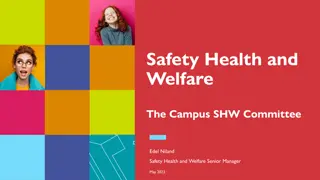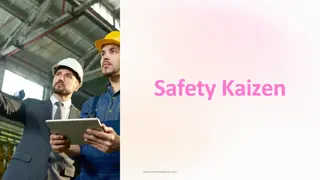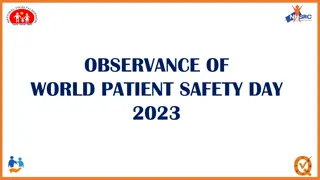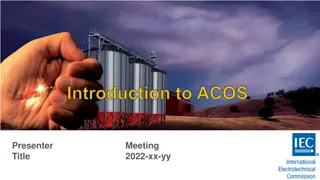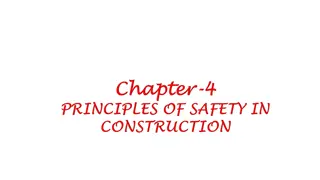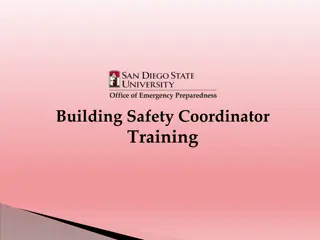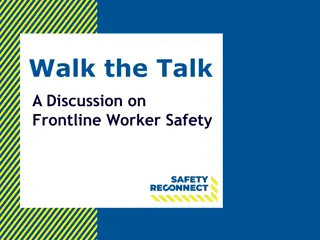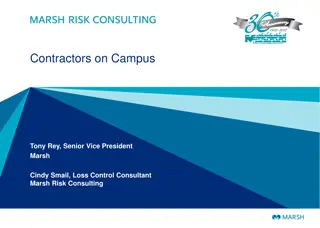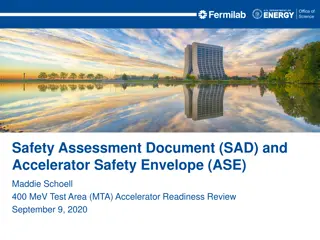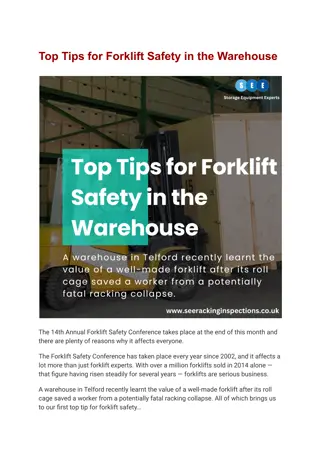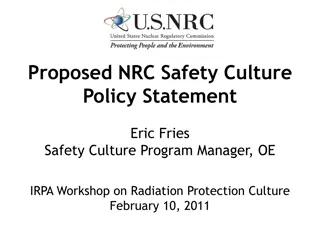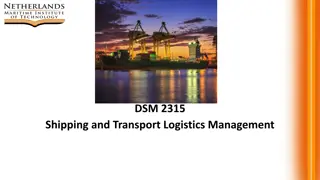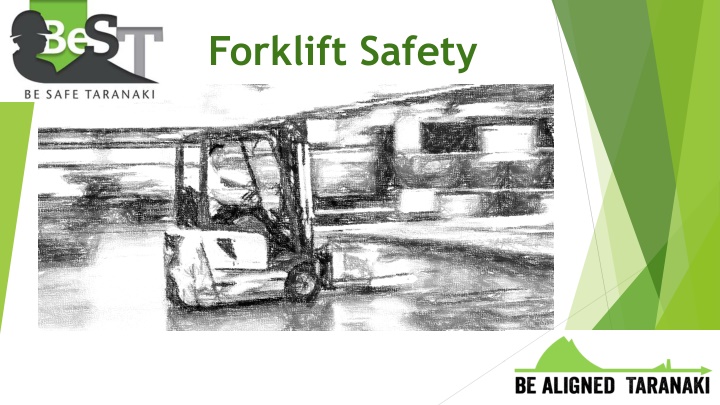
Workplace Forklift Safety and Spotter Guidelines
Learn about forklift safety measures, safe operation practices, driver competency, workplace competency assessments, and the role of spotters in maneuvering mobile plant vehicles. Find out when a spotter is required, the hazards they look out for, and examples of machines that may need spotters. Stay informed about safe practices to prevent accidents and ensure workplace safety.
Download Presentation

Please find below an Image/Link to download the presentation.
The content on the website is provided AS IS for your information and personal use only. It may not be sold, licensed, or shared on other websites without obtaining consent from the author. If you encounter any issues during the download, it is possible that the publisher has removed the file from their server.
You are allowed to download the files provided on this website for personal or commercial use, subject to the condition that they are used lawfully. All files are the property of their respective owners.
The content on the website is provided AS IS for your information and personal use only. It may not be sold, licensed, or shared on other websites without obtaining consent from the author.
E N D
Presentation Transcript
Safe Forklift Operation Manual https://besafe.nz/safe-forklift-operation-manual/
Driver Competency
Workplace Assessment of Competency Effective pre-start checks. Interpreting forklift load charts. Refueling/charging. Safe maneuvering. Load preparation. Identifying route & associated hazards. This Photo by Unknown Author is licensed under CC BY-ND
Workplace Assessment of Competency Continued. Ability to calculate bridging plate max loads (Workplace specific) Compliance with workplace speed limits. Safe accessing/exiting of plant. Ability to correctly fit designed/ approved accessories. This Photo by Unknown Author is licensed under CC BY-ND
What is a Spotter? Person who aids an operator of mobile plant to manoeuvre the vehicle safely when operator visibility is restricted. | Basic Principles of Spotting Mobile Plant - NZ
Spotters Spotters need to be competent in identifying the following: Load stability Hazardous infrastructure/equipment Pedestrians/vehicles/mobile plant risks Obscured vision of driver Stacking/unstacking pallet risks. Ensuring loads fit along intended route. Boom strike risks along the intended route. Unstable/uneven surfaces. This Photo by Unknown Author is licensed under CC BY-ND
When is a Spotter Required Spotters are needed when there is a risk of mobile plant coming into contact with people, services, buildings or process plant & equipment. Anytime mobile plant drives off designated roadways and into the process areas of the plant. Anytime when the operator s vision may be obstructed. As required by PTW, SOP, JSA etc. | Basic Principles of Spotting Mobile Plant - NZ
Examples of machines that may require spotters | Basic Principles of Spotting Mobile Plant - NZ
Typical Hazards When Spotting Mobile Plant Line of fire. Crush injury. Slips trips & falls. Contact with live plant resulting in LOC & explosion events. Dropped items. Underground and overhead services. SIMOPS. | Basic Principles of Spotting Mobile Plant - NZ
Responsibilities Communication is Key Spotter and driver must hold a toolbox prior to starting the task. Plan the route where the driver needs to go: What are the hazards? Is there a safer alternative route? Agree on method for communicating (radio, hand signals). Ensure others in the vicinity are made aware of the task. Spotter must remain outside of any machine swing area / line of fire at all times. Immediately stop the work or operation if: Any other person enters the machine swing or work area. Communication between driver and spotter is lost. | Basic Principles of Spotting Mobile Plant - NZ
Hand Signals When Spotting | Basic Principles of Spotting Mobile Plant - NZ
Be Seen, Be Safe Spotting Vehicles Safely Maintain constant eye or radio contact with the driver at all times. Signal to stop immediately if contact is lost. Don t become distracted. Never walk backwards while spotting a moving vehicle. Never put yourself in the between the path of a moving vehicle and any obstacle. Signal to stop the vehicle if there is any doubt or danger. | Basic Principles of Spotting Mobile Plant - NZ
Peer Review - Elements The purpose of the peer review is for a Forklift Driver to observe, check and comment on the performance of one of their peers operating a forklift as a means of reflection. Self-review should take place during and after this observation to determine self-performance and opportunities for improvement to driver behaviour. Reference to the relevant company standards should be undertaken.
Peer Review - Questions Has the pre-start check been completed? Is the operator looking behind them when reversing? Is the forklift moving within the site speed limit? When carrying a load, are the forks tilted back? Is any separate component of the load sitting above the mast, unsecured? Does the driver appear aware of pedestrians? Does the driver check the rear of the forklift when turning? Does the driver check the forks of the forklift when turning? Is the forklift parked in the correct position when stationary? Is the load secure / safe? Is the load left in a safe position or state when unloaded? Is the forklift horn being used when necessary? Does the operator enter and exit the forklift safely? Does the driver brake suddenly, creating risk? Is the driver stacking loads according to a Standard? Is the forklift load being carried at the correct height from the ground? Does the driver appear aware of overhead risks Are they looking?
Key Considerations for the Observer: 1. When I am doing the task being observed, how do I drive the Forklift? 2. Are there things that this driver does that I do, positive or negative? 3. Where could I improve as a Forklift driver? 4. Are there any actions we do as common practice that are dangerous and need to change? This Photo by Unknown Author is licensed under CC BY
Working safely around Forklifts https://www.safetymanualosha.com/working-safely-around-forklifts/ This Photo by Unknown Author is licensed under CC BY-SA-NC
Pedestrian Safety protecting pedestrians in the workplace from forklift accidents and injuries - pedestrians need training too! Pedestrian did not see the lift truck Blind Corners, intersections Pedestrian did not hear the truck. internal combustion forklifts, electric forklifts Pedestrian coming into too close proximity. Forklifts can pose a danger from all four sides.
Traffic Management Employers and self-employed persons have a duty to identify hazards in the workplace and to assess and control risks in the workplace. To develop an adequate forklift traffic management plan, employers and self-employed people must: Identify all hazards associated with using a forklift at the workplace. Assess the risks to people's health and safety and make sure the traffic management plan includes ways to control those risks that will ensure people's safety.
Helpful links https://www.worksafe.govt.nz/dmsdocument/215-acop-training-operators-and- instructors-of-powered-industrial-lift-trucks https://worksafe.govt.nz/about-us/news-and-media/safety-in-hardware-supplier- yards https://worksafe.govt.nz/about-us/news-and-media/media-release-fatal-interactions- between-forklifts-and-people https://worksafe.govt.nz/topic-and-industry/machinery/forklifts/controlling-the-risk- of-carbon-monoxide-poisoning/forklifts-and-carbon-monoxide https://worksafe.govt.nz/about-us/news-and-media/critical-to-address-the-risks- from-forklifts https://worksafe.govt.nz/about-us/news-and-media/forklift-incident-a-reminder-for- companies-to-learn-from-their-mistakes This Photo by Unknown Author is licensed under CC BY-SA-NC
Thank you Q & A


